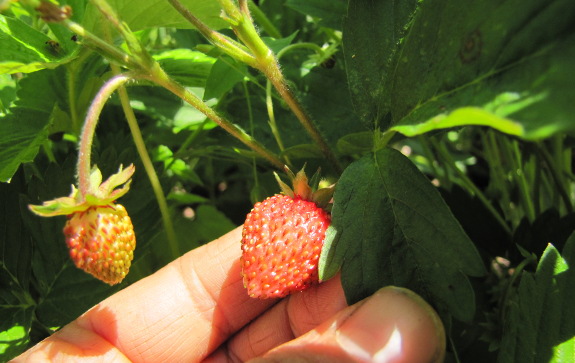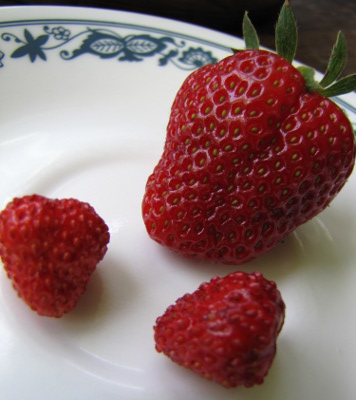
Alpine vs. June-bearing strawberries

Forest gardening books
sing the praises of alpine strawberries, promising stunning flavor in a
shade-tolerant plant that bears all summer, but my experience hasn't
been as positive. I started
some alpine strawberries from seed last year and transplanted
them into a slightly shady raised bed below my ailing dwarf
cherry. The strawberries produced that same summer, but the
fruits were a bit mealy and lacked the complex flavor that I'm used to
in my homegrown strawberries.
 I figured the dull flavor
could be an artifact of the time of year, so left the alpine
strawberries in place, planning a side by side comparison this
spring. But when our first strawberries ripened up, Mark and I
both decided that the alpines didn't hold a candle to our favorite
Honeoyes.
I figured the dull flavor
could be an artifact of the time of year, so left the alpine
strawberries in place, planning a side by side comparison this
spring. But when our first strawberries ripened up, Mark and I
both decided that the alpines didn't hold a candle to our favorite
Honeoyes.
The alpines did win very
slightly on one point, though --- earliness. We ate our first
alpine strawberries on May 7 and didn't get our first June-bearing
strawberriers until May 9. Those two early fruits aren't going to
be enough to turn alpine strawberries into a core crop on our farm,
though.
That said, I wonder if
the problem with our alpine strawberries could stem from my method of
starting them from seed. Nearly all fruits are cloned rather than
grown from seed since the genetic diversity in a batch of seeds will
result in a bunch of duds and only a few winning plants. Granted,
books tell me that it's fine to start alpine strawberries from seed,
but I'm not so sure. Has anyone eaten really award-winning alpine
strawberries? Do you know what variety they were and how they
were started?
Want more in-depth information? Browse through our books.
Or explore more posts by date or by subject.
About us: Anna Hess and Mark Hamilton spent over a decade living self-sufficiently in the mountains of Virginia before moving north to start over from scratch in the foothills of Ohio. They've experimented with permaculture, no-till gardening, trailersteading, home-based microbusinesses and much more, writing about their adventures in both blogs and books.
Want to be notified when new comments are posted on this page? Click on the RSS button after you add a comment to subscribe to the comment feed, or simply check the box beside "email replies to me" while writing your comment.

I started some alpine strawberries from seed this year, albeit a bit late, but from inspiration I found here. I had two varieties, one didn't bother to sprout at all and the other is doing very well (every soil cell - that is, in the paper egg carton, has at least one sprout in it) What's the best indicator of when to transplant them to a more permanent situation? Partial shade, you say? right now they have their first set of actual leaves.
I've noticed a patch of June bearing strawberries that my father planted many years ago is making something of a resurgence this spring after having slowly dying out completely, or so I thought. I've been digging up the new plants I find and putting them in hanging pots pinching off the blossoms, hoping it will encourage them to send out runners and reproduce.
Dean --- I hope I didn't steer you wrong with the alpines! I'll be very curious to hear how yours do. I transplanted my alpines out at the beginning of May last year --- I think that anytime you're not going to get cold freezes and the tiny plants are big enough that they won't get swallowed by mulch is fine. I don't think full sun would hurt them, if you've got the space, but partial shade is what I read.
Your June-bearers probably just need some love (aka ripping out most of the plants so that the few remaining have room to grow.) Strawberries will quickly take over a patch of ground and turn into a mass that doesn't grow well, but transplanting babies to a new bed or just ripping out plants so that each one has at least a foot of plant-less soil in every direction should renovate the existing bed. Then give them some good compost and mulch, and they'll probably thrive. I like to start with entirely new beds about every third year, transplanting rooted runners and then putting down a kill mulch on the old patch so I can turn it into something else.
Rebecca --- that's an excellent point. I was simplifying a bit in the post, though --- I actually have alpines in two different tree raised beds, and the peach in the other bed is doing great. (I'm pretty sure the cherry problem is due to endless munching by Japanese beetles every summer --- I just can't reach the ones very high in the tree to get rid of them.) If anything, I would expect the soil quality to be higher in the tree beds than in the conventional garden since I tend to give the trees the best compost (manure) and mulch (tree leaves) possible, figuring they're a longer term investment.
What is different there in a bad way is partial shade and lack of regular watering --- the June-bearers get pretty much full sun and an inch of water per week during the growing season. Granted, the cherry tree is doing so badly that the strawberries in its bed have barely any shade, and I haven't watered the June strawberries yet this year either, but it's possible both of those factors could have residual effects from last summer. Maybe I should transplant an alpine into the main garden for a more fair comparison.
Excellent question/point! An even better known example is the Irish Potato Famine that resulted from everyone growing the same variety of potato. (We don't tend to think of the way we grow potatoes as cloning, but it is.)
That said, with many types of fruit, there's such a huge difference between a named variety and most seedlings that it's not even worth growing the seedlings. The way I deal with that is hedging my bets, growing several different types of apples, pears, etc. Not counting my alpine strawberries, I'm currently growing three varieties of strawberries, which also helps extend the season since one is very early, one's a bit later, and the third is "ever-bearing" and gives some strawberries through the summer.
At work, we grow one June-bearing and and three ever-bearing strawberries. I've plucked fruits off both and both seemed fine to me. We get our strawberry plants shipped in as bare-root seedlings. We also grow a hanging basket with a different ever-bearing strawberry called Elan. Those are small fruits but absolutely delicious!
From what I've read, June-bearing strawberries typically do better after the first year, but ever-bearing varieties do worse and are typically treated as an annual.
I've only heard stories (from my uncle) about alpine berries being the sweetest berries, but so frustrating because of how tiny they are and how slowly the seeds germinate. My strawberry plants this year are hybrids, and clones, and we started the spring with berries that were slow to ripen, quick to be eaten by pests, and very tiny. Within a month or two, the berries were much larger, and so sweet and perfect. Now they are getting dry and mealy in the heat/drought... so maybe your experience with the alpines is something other than the variety. Personally, i'd give them another chance.
I was setting up a "plant guild" for my permaculture project and I thought about adding alpine berries to a chicken forage pasture. It seems like the chickens would be happier pursuing tiny little berries than I would, and the quality wouldn't be so important. There's just the matter of keeping the chickens from scratching them to death, but I think some type of narrow, raised plantings, or intermingling with more deeply rooted protector plants might interfere with chicken scratching.
Edward and Sara --- I've been thinking about your comments as I weeded this morning and eyed the strawberries that aren't quite ripe enough to eat. (So tough to keep my hands off!) I'm starting to suspect that the difference of opinion between many people and me about alpine strawberries may be due to what we're comparing them to. Compared to storebought strawberries, even in season, alpine strawberries are amazing. The thing is, though, our June-bearing strawberries are just double amazing.
Sara --- I love your idea of alpine strawberries in the chicken run. I'd actually meant to throw my extra seeds in their pasture this spring and forgot.
Yes but many different varieties/colors/flavors etc.
see: http://fraisesdesbois.com/varieties/
Good luck.